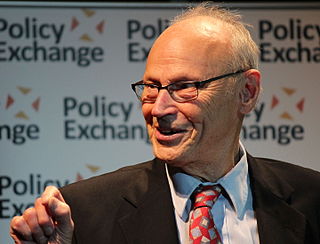Related Research Articles

Art is a diverse range of human activity and its resulting product that involves creative or imaginative talent generally expressive of technical proficiency, beauty, emotional power, or conceptual ideas.
Aesthetics is the branch of philosophy concerned with the nature of beauty and the nature of taste; and functions as the philosophy of art. Aesthetics examines the philosophy of aesthetic value, which is determined by critical judgements of artistic taste; thus, the function of aesthetics is the "critical reflection on art, culture and nature".
Deconstruction is a loosely-defined set of approaches to understanding the relationship between text and meaning. The concept of deconstruction was introduced by the philosopher Jacques Derrida, who described it as a turn away from Platonism's ideas of "true" forms and essences which are valued above appearances.

Literary theory is the systematic study of the nature of literature and of the methods for literary analysis. Since the 19th century, literary scholarship includes literary theory and considerations of intellectual history, moral philosophy, social philosophy, and interdisciplinary themes relevant to how people interpret meaning. In the humanities in modern academia, the latter style of literary scholarship is an offshoot of post-structuralism. Consequently, the word theory became an umbrella term for scholarly approaches to reading texts, some of which are informed by strands of semiotics, cultural studies, philosophy of language, and continental philosophy.

A genre of arts criticism, literary criticism or literary studies is the study, evaluation, and interpretation of literature. Modern literary criticism is often influenced by literary theory, which is the philosophical analysis of literature's goals and methods. Although the two activities are closely related, literary critics are not always, and have not always been, theorists.
Allusion is a figure of speech, in which an object or circumstance from an unrelated context is referred to covertly or indirectly. It is left to the audience to make a direct connection. Where the connection is directly and explicitly stated by the author, it is instead usually termed a reference. In the arts, a literary allusion puts the alluded text in a new context under which it assumes new meanings and denotations. It is not possible to predetermine the nature of all the new meanings and inter-textual patterns that an allusion will generate. Literary allusion is closely related to parody and pastiche, which are also "text-linking" literary devices.
In literary criticism, close reading is the careful, sustained interpretation of a brief passage of a text. A close reading emphasizes the single and the particular over the general, via close attention to individual words, the syntax, the order in which the sentences unfold ideas, as well as formal structures.

Reader-response criticism is a school of literary theory that focuses on the reader and their experience of a literary work, in contrast to other schools and theories that focus attention primarily on the author or the content and form of the work.
New Criticism was a formalist movement in literary theory that dominated American literary criticism in the middle decades of the 20th century. It emphasized close reading, particularly of poetry, to discover how a work of literature functioned as a self-contained, self-referential aesthetic object. The movement derived its name from John Crowe Ransom's 1941 book The New Criticism.
Monroe Curtis Beardsley was an American philosopher of art.
William Kurtz Wimsatt Jr. was an American professor of English, literary theorist, and critic. Wimsatt is often associated with the concept of the intentional fallacy, which he developed with Monroe Beardsley in order to question the importance of an author's intentions for the creation of a work of art.
"The Death of the Author" is a 1967 essay by the French literary critic and theorist Roland Barthes (1915–1980). Barthes' essay argues against traditional literary criticism's practice of relying on the intentions and biography of an author to definitively explain the "ultimate meaning" of a text. Instead, the essay emphasizes the primacy of each individual reader's interpretation of the work over any "definitive" meaning intended by the author, a process in which subtle or unnoticed characteristics may be drawn out for new insight. The essay's first English-language publication was in the American journal Aspen, no. 5–6 in 1967; the French debut was in the magazine Manteia, no. 5 (1968). The essay later appeared in an anthology of Barthes' essays, Image-Music-Text (1977), a book that also included his "From Work to Text".
Affective fallacy is a term from literary criticism used to refer to the supposed error of judging or evaluating a text on the basis of its emotional effects on a reader. The term was coined by W.K. Wimsatt and Monroe Beardsley in 1949 as a principle of New Criticism which is often paired with their study of The Intentional Fallacy.
The historical-grammatical method is a modern Christian hermeneutical method that strives to discover the biblical authors' original intended meaning in the text. According to the historical-grammatical method, if based on an analysis of the grammatical style of a passage, it appears that the author intended to convey an account of events that actually happened, then the text should be taken as representing history; passages should only be interpreted symbolically, poetically, or allegorically if to the best of our understanding, that is what the writer intended to convey to the original audience. It is the primary method of interpretation for many conservative Protestant exegetes who reject the historical-critical method to various degrees, in contrast to the overwhelming reliance on historical-critical interpretation in biblical studies at the academic level.

Eric "E. D." Donald Hirsch Jr. is an American educator, literary critic, and theorist of education. He is professor emeritus of humanities at the University of Virginia.
The implied author is a concept of literary criticism developed in the 20th century. Distinct from the author and the narrator, the term refers to the "authorial character" that a reader infers from a text based on the way a literary work is written. In other words, the implied author is a construct, the image of the writer produced by a reader as called forth from the text. The implied author may or may not coincide with the author's expressed intentions or known personality traits.
"The Frontiers of Criticism" is a lecture given by T. S. Eliot at the University of Minnesota in 1956. It was reprinted in On Poetry and Poets, a collection of Eliot's critical essays, in 1957. The essay is an attempt by Eliot to define the boundaries of literary criticism: to say what does, and what does not, constitute truly literary criticism, as opposed to, for example, a study in history based upon a work of literature. The essay is significant because it represents Eliot's response to the New Critical perspective which had taken the academic study of literature by storm during Eliot's lifetime. It also presents an analysis of some of its author's own poetic works, an unusual characteristic for modern criticism—it has become far more usual today for poets and critics to be in separate camps, rather than united in one individual. Perhaps even more importantly, it demonstrates the progress and change in Eliot's own critical thought over the years between 1919 and 1956.
Terry Michael Barrett is an American art critic, and Professor Emeritus at Ohio State University. His many books, anthology chapters, and articles about contemporary art, art criticism, aesthetics, and the teaching of these, have had a significant impact on the field.

The Mencius is a collection of conversations, anecdotes, and series of genuine and imagined interviews by the Confucian philosopher Mencius. The book is one of the Chinese Thirteen Classics, and explores Mencius' views on the topics of moral and political philosophy, often as a dialogue with the ideas presented by Confucianism. The interviews and conversations are depicted as being either between Mencius and the various rulers of the Warring States period, or with his students and other contemporaries. The book documents Mencius' travel across the states, and his philosophical conversations and debates with those he meets on his journey. A number of scholars suggest that the text was not written by Mencius himself, but rather by his disciples. The text is believed to have been written during the late 4th century BC.
Daniel Osher Nathan is an American philosopher and Professor of Philosophy at Texas Tech University. He is known for his expertise on aesthetics, ethical theory, and philosophy of law.
References
- ↑ A. Huddleston, "The Conversation Argument for Actual Intentionalism", British Journal of Aesthetics52(3):241–256 (2012).
- ↑ Sutcliffe, Peter (2013). Is There an Author in this Text? Discovering the Otherness of the Text. Eugene, OR: Wipf & Stock Publishers. p. 9. ISBN 9781620328231.
- 1 2 3 4 5 6 7 8 9 10 11 "Art and Interpretation | Internet Encyclopedia of Philosophy". Internet Encyclopedia of Philosophy. Retrieved 2024-05-07.
- 1 2 "On Authorial Intent". THE MEDIEVAL PROFESSOR. 2019-06-24. Retrieved 2024-05-07.
- 1 2 Irvin, Sherri (2006). "Authors, Intentions and Literary Meaning". Philosophy Compass. 1 (2): 114–128. doi:10.1111/j.1747-9991.2006.00016.x.
- ↑ Lewis, CS (1961). An Experiment in Criticism. Cambridge University Press. ISBN 9781107604728.
- 1 2 Ward, Matthew (2014-09-09). "Authorial Intent and Validity in Interpretation - A Mind for Madness". amindformadness.com. Retrieved 2024-05-07.
- ↑ Hirsch, E. D. (1967). Validity in Interpretation. Yale University Press. p. 1. ISBN 9780300157390.
- 1 2 Knox, Alan (2009-02-03). "Validity in Interpretation by E.D. Hirsch". Archived from the original on 2010-08-05. Retrieved 2024-05-07.
- ↑ Garcia, L. Jared (2018-10-02). "Book Review: "Validity of Interpretation" by E.D. Hirsch". LeeJaredGarcia.Com. Retrieved 2024-05-07.
- ↑ Hirsch, E.D. (1967). Validity in Interpretation. Yale University Press. pp. 19–24. ISBN 9780300157390.
- ↑ Gilmore, Jonathan (2021-10-09). "Only Imagine: Fiction, Interpretation, and Imagination | Reviews | No…". Archived from the original on 2021-10-09.
{{cite web}}: CS1 maint: bot: original URL status unknown (link) - 1 2 Bevir, Mark (1999). The logic of the history of ideas. Internet Archive. Cambridge, U.K. ; New York : Cambridge University Press. ISBN 978-0-511-00347-9.
- ↑ Juhl, P. D. (Peter D. ) (1980). Interpretation, an essay in the philosophy of literary criticism. Internet Archive. Princeton, N.J. : Princeton University Press. ISBN 978-0-691-07242-5.
- 1 2 3 4 Bevir, Mark (2000). "The Role of Contexts in Understanding and Explanation". Human Studies. 23 (4): 395–411. ISSN 0163-8548.
- ↑ "intentional fallacy". Oxford Reference. doi:10.1093/oi/authority.20110803100006219 . Retrieved 2024-05-09.
- ↑ Wimsatt, W. K.; Beardsley, M. C. (1946). "The Intentional Fallacy". The Sewanee Review. 54 (3): 468–488. ISSN 0037-3052.
- ↑ Duelfer, Jon. "The Intentional Fallacy". The Inquiring Reader. Retrieved 2024-05-09.
- ↑ Barthes, Roland (1967). Cazeaux, Clive (ed.). "The Death of the Author". Routledge: 519–524. doi:10.4324/9781351226387-35. ISBN 978-1-351-22638-7.
{{cite journal}}: Cite journal requires|journal=(help) - 1 2 Wimsatt, W. K.; Beardsley, M. C. (1946). "The Intentional Fallacy". The Sewanee Review. 54 (3): 468–488. JSTOR 27537676. Revised and republished in The Verbal Icon: Studies in the Meaning of Poetry. University Press of Kentucky. 1954. ISBN 0813128579.
- ↑ Mtata, Kenneth; Koester, Craig (2016). To All the Nations: Lutheran Hermeneutics and the Gospel of Matthew. Evangelische Verlagsanstalt. p. 40. ISBN 978-3-374-04375-0.
- ↑ Bennett, Andrew, ed. (1995). Readers and reading. Longman critical readers (1. publ ed.). London: Longman. ISBN 978-0-582-21290-9.
- ↑ Appleman, Deborah (2015). Critical Encounters in Secondary English: Teaching Literary Theory to Adolescents, Third Edition. Teachers College Press. p. 32. ISBN 978-0-8077-7355-0.
- ↑ Selden, Raman (1995). The Cambridge History of Literary Criticism: Volume 8, From Formalism to Poststructuralism. Cambridge: Cambridge University Press. p. 279. ISBN 0-521-30013-4.
- ↑ Green, Richard D. (2012). Foundations in Music Bibliography. New York, NY: The Haworth Press. pp. 15–16. ISBN 978-1-56024-512-4.